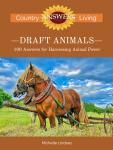
The story of the Suffolk Punch is that of a quiet farm worker, lacking in incredible incidents, but nevertheless important. The breed’s lineage is obscure, but ancient, with written records tracing back to the 1500s, yet already referring to the horse as the “Old Breed.”
For centuries the Suffolk Punch worked the heavy clay fields of its home in eastern England. No one sought to improve it through crossing with other breeds for many years—it was invaluable exactly as it was. In fact, it was so invaluable few farmers could afford to sell their horses. So the Suffolk Punch remained relatively isolated in its native home, few in numbers but high in the esteem of its owners.
Because the breed’s population was always low, one sire came to the forefront. This stallion was Crisp’s Horse of Ufford, born in 1768. All modern Suffolk Punch horses trace back to him.
The modern Suffolk Punch may have been influenced by crossbreeding experiments in the early 1800s. Many breeders at this time were out to produce the perfect coach horse. The Suffolk Punch was crossed with trotters from Yorkshire and Norfolk, as well as the occasional Thoroughbred. The resulting coach horse was indeed an animal well suited to his task, with the strength and substance of the Suffolk Punch and the activity of the trotter. Many horse experts of the day, however, felt that the purebred Suffolk Punch suffered in the process, as it was allowed to die out and a new draft horse with coach horse influence took its place. This horse, they claimed, was indeed a willing worker, but it just couldn’t plow as much land in a day as the old horse.
Even so, the breed was still worthy of a place in America. Limited importations began in 1880. Farmers in New England and the Midwest appreciated the abilities and work ethic of the breed, but limited numbers in England meant that there were never enough Suffolk Punch horses to go around.
The rise of mechanization at the end of World War II drove the Suffolk Punch to the brink of extinction. The American population fell to a low of 50 horses, most of which lived on three farms in Iowa.
Fortunately, the 1960s brought renewed interest in draft horses of all breeds. Several Suffolk Punch horses were imported to the United States again in the 1970s, which provided England with an impetus to preserve the rare breed. Crossbreeding with Belgian draft horses was also carried out in America in the 1970s and early 1980s to prevent a genetic disaster.
The Suffolk Punch continues to increase in numbers today, although it is still rare. Its global population is estimated at 520 animals.
Uses
The Suffolk Punch has a long history of working on the farm, and it is in this role that it excels today. It is equally at home in the field or the woodlot. It has also earned a place in recreational driving, despite the fact that it is not as flashy as other draft breeds.
A purebred Suffolk Punch can make a good saddle horse for a heavyweight rider. Its crossbred offspring frequently have the strength and stamina necessary to perform well in jumping and eventing.
Temperament
For work ethic and a sweet, loving nature, the Suffolk Punch is unequaled among horses. Due to its calmness and willingness, this gentle giant is easy to break and safe to work with. It is quiet and friendly around children. However, the Suffolk Punch can face its work with pluck. It will push its strength to the limit rather than give up.
Health
The Suffolk Punch is the ultimate low-maintenance draft horse. It has a robust constitution, and it lacks the feathering that causes disease in most heavy horse breeds. Despite the scarcity of the breed, inbreeding has not become a problem thanks to the proportionately large number of breeding stallions to choose from.
Pros
- Heat tolerance.
- Hardiness.
- Surprisingly low feed requirements for a draft horse.
- Early maturity.
- Exceptional longevity.
- Fertility.
- Uniformity, which makes it easy to find a matching team.
- Power.
- Tremendous stamina.
- Fast working pace.
Cons
- Scarcity.
Complete Series
Helpful Resource
Draft Animals
This book from Homestead on the Range answers common questions about working with draft horses, including how to choose the right breed for you. Free sample pages are available.



